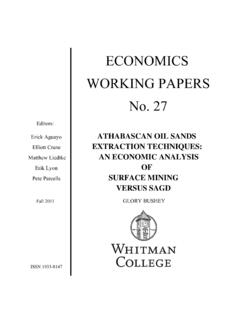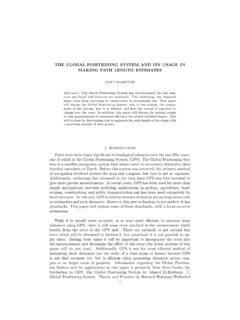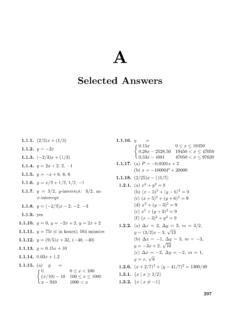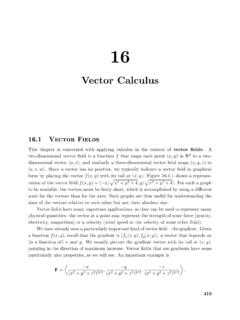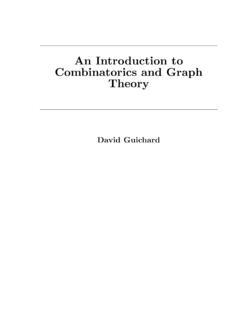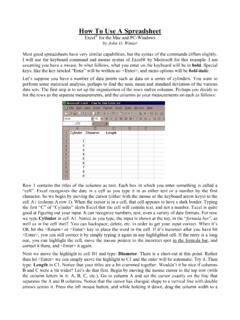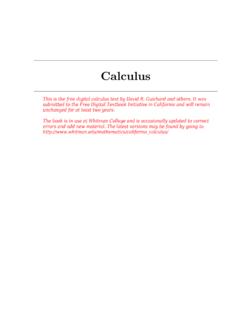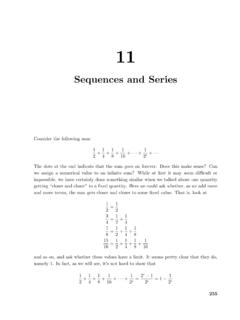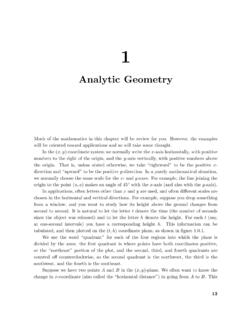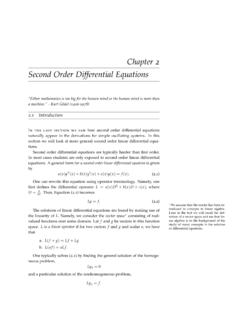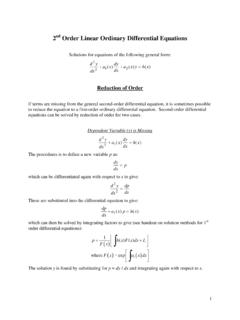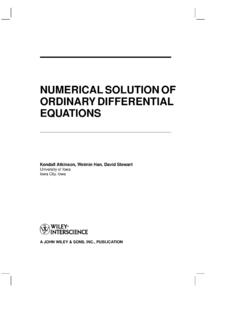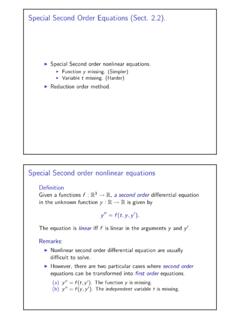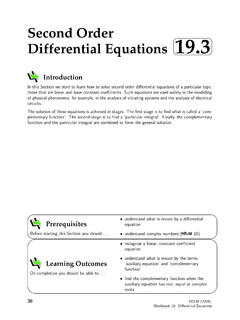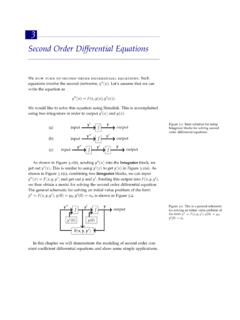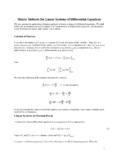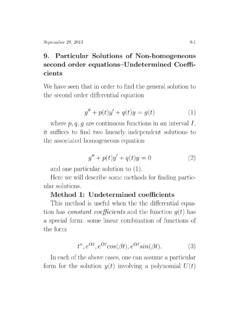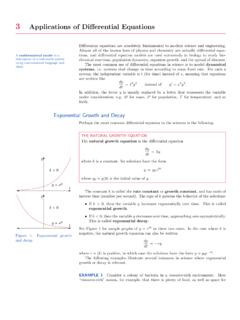Transcription of Differential Equations - Whitman College
1 17 Differential EquationsMany physical phenomena can be modeled using the language ofcalculus. For example,observational evidence suggests that the temperature of a cup of tea (or some other liquid)in a room of constant temperature will cool over time at a rateproportional to the differencebetween the room temperature and the temperature of the symbols, iftis the time,Mis the room temperature, andf(t) is the temperatureof the tea at timetthenf (t) =k(M f(t)) wherek >0 is a constant which will dependon the kind of tea (or more generally the kind of liquid) but not on the room temperatureor the temperature of the tea. This isNewton s law of coolingand the equation thatwe just wrote down is an example of adifferential equation. Ideally we would like tosolve this equation, namely, find the functionf(t) that describes the temperature overtime, though this often turns out to be impossible, in which case various approximationtechniques must be used.
2 The use and solution of differentialequations is an importantfield of mathematics; here we see how to solve some simple but useful types of , a differential equation is an equation in which one or more of the derivativesof some function appear. Typically, a scientific theory willproduce a differential equation(or a system of differential Equations ) that describes or governs some physical process, butthe theory will not produce the desired function or functions from section that when the variable is time the derivative of a functiony(t)is sometimes written as yinstead ofy ; this is quite common in the study of 17 Differential start by considering Equations in which only the first derivative of the function order differential equationis an equation of the formF(t, y, y) = 0.
3 A solution of a first order differential equation is a functionf(t) that makesF(t, f(t), f (t)) = 0 for every value ,Fis a function of three variables which we labelt,y, and y. It is understoodthat ywill explicitly appear in the equation althoughtandyneed not. The term firstorder means that the first derivative ofyappears, but no higher order derivatives equation from Newton s law of cooling, y=k(M y) is a firstorder differential equation;F(t, y, y) =k(M y) y=t2+1 is a first order differential equation;F(t, y, y) = y t2 solutions to this equation are of the formt3/3 +t+ order initial value problemis a system of equationsof the formF(t, y, y) = 0,y(t0) =y0. Heret0is a fixed time andy0is a number. Asolution of an initial value problem is a solutionf(t) of the differential equation that alsosatisfies theinitial conditionf(t0) = initial value problem y=t2+ 1,y(1) = 4 has solutionf(t) =t3/3 +t+ 8 general first order equation is rather too general, that is, we can t describe methodsthat will work on them all, or even a large portion of them.
4 We can make progress withspecific kinds of first order differential Equations . For example, much can be said aboutequations of the form y= (t, y) where is a function of the two variablestandy. Underreasonable conditions on , such an equation has a solution and the corresponding initialvalue problem has a unique solution. However, in general, these Equations can be verydifficult or impossible to solve this specific example of an initial value problem for New-ton s law of cooling: y= 2(25 y),y(0) = 40. We first note that ify(t0) = 25, the righthand side of the differential equation is zero, and so the constant functiony(t) = 25 is asolution to the differential equation. It is not a solution tothe initial value problem, sincey(0)6= 40. (The physical interpretation of this constant solution is that if a liquid is atthe same temperature as its surroundings, then the liquid will stay at that temperature.)
5 First order Differential Equations457So long asyis not 25, we can rewrite the differential equation asdydt125 y= 2125 ydy= 2dt,so 125 ydy= 2dt,that is, the two anti-derivatives must be the same except fora constant difference. We cancalculate these anti-derivatives and rearrange the results: 125 ydy= 2dt( 1) ln|25 y|= 2t+C0ln|25 y|= 2t C0= 2t+C|25 y|=e 2t+C=e 2teCy 25 = eCe 2ty= 25 eCe 2t= 25 +Ae eC= e C0is some non-zero constant. Since we wanty(0) = 40, wesubstitute and solve forA:40 = 25 +Ae015 =A,and soy= 25+15e 2tis a solution to the initial value problem. Note thatyis never 25, sothis makes sense for all values oft. However, if we allowA= 0 we get the solutiony= 25to the differential equation, which would be the solution to the initial value problem if wewere to requirey(0) = 25.
6 Thus,y= 25 +Ae 2tdescribes all solutions to the differentialequation y= 2(25 y), and all solutions to the associated initial value could we solve this problem? Our solution depended on rewriting the equationso that all instances ofywere on one side of the equation and all instances oftwere on theother; of course, in this case the onlytwas originally hidden, since we didn t writedy/dtin the original equation. This is not required, 17 Differential EquationsEXAMPLE the differential equation y= 2t(25 y). This is almostidentical to the previous example. As before,y(t) = 25 is a solution. Ify6= 25, 125 ydy= 2t dt( 1) ln|25 y|=t2+C0ln|25 y|= t2 C0= t2+C|25 y|=e t2+C=e t2eCy 25 = eCe t2y= 25 eCe t2= 25 +Ae before, all solutions are represented byy= 25 +Ae t2, allowingAto be first order differential equation isseparableif it can be writtenin the form y=f(t)g(y).
7 As in the examples, we can attempt to solve a separable equation by converting to theform 1g(y)dy= f(t) technique is calledseparation of variables. The simplest (in principle) sort ofseparable equation is one in whichg(y) = 1, in which case we attempt to solve 1dy= f(t) can do this if we can find an anti-derivative off(t).Also as we have seen so far, a differential equation typicallyhas an infinite numberof solutions. Ideally, but certainly not always, a corresponding initial value problem willhave just one solution. A solution in which there are no unknown constants remaining iscalled aparticular general approach to separable Equations is this: Suppose we wish to solve y=f(t)g(y) wherefandgare continuous functions. Ifg(a) = 0 for someatheny(t) =ais a constant solution of the equation, since in this case y= 0 =f(t)g(a).
8 For example, y=y2 1 has constant solutionsy(t) = 1 andy(t) = find the nonconstant solutions, we note that the function 1/g(y) is continuous whereg6= 0, so 1/ghas an antiderivativeG. LetFbe an antiderivative off. Now we writeG(y) = 1g(y)dy= f(t)dt=F(t) +C,soG(y) =F(t) +C. Now we solve this equation First order Differential Equations459Of course, there are a few places this ideal description could go wrong: we need tobe able to find the antiderivativesGandF, and we need to solve the final equation fory. The upshot is that the solutions to the original differential equation are the constantsolutions, if any, and all functionsythat satisfyG(y) =F(t) + the differential equation y=ky. Whenk >0, this de-scribes certain simple cases of population growth: it says that the change in the populationyis proportional to the population.
9 The underlying assumption is that each organism inthe current population reproduces at a fixed rate, so the larger the population the morenew organisms are produced. While this is too simple to modelmost real populations, itis useful in some cases over a limited time. Whenk <0, the differential equation describesa quantity that decreases in proportion to the current value; this can be used to modelradioactive constant solution isy(t) = 0; of course this will not be the solution to anyinteresting initial value problem. For the non-constant solutions, we proceed much asbefore: 1ydy= k dtln|y|=kt+C|y|=ekteCy= eCekty= , if we allowA= 0 this includes the constant solution, and we can simply saythaty=Aektis the general solution. With an initial value we can easily solve forAto getthe solution of the initial value problem.
10 In particular, ifthe initial value is given for timet= 0,y(0) =y0, thenA=y0and the solution isy= of the following Equations are separable?a. y= sin(ty)b. y= y=td. y= (t3 t) arcsin(y)e. y=t2lny+ y= 1/(1 +t2). the initial value problem y=tnwithy(0) = 1 andn 0. y= lnt. 460 Chapter 17 Differential the constant solutions (if any) of y=tsiny. the constant solutions (if any) of y=tey. y=t/y. y=y2 1. y=t/(y3 5). You may leave your solution in implicit form: that is, you may stoponce you have done the integration, without solving fory. a non-constant solution of the initial value problem y=y1/3,y(0) = 0, using separationof variables. Note that the constant functiony(t) = 0 also solves the initial value shows that an initial value problem can have more than one solution.
